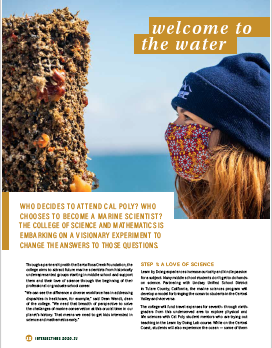Welcome to the Water

Who decides to go to Cal Poly? Who chooses to become a marine scientist? The college of science and mathematics is embarking on a visionary experiment to change the answers to these questions.
Through a partnership with the Santa Rosa Creek Foundation, the college aims to attract future marine scientists from historically underrepresented groups starting in middle school and support them and their love of science through the beginning of their professional or graduate school career.
“We can see the difference a diverse workforce has in addressing disparities in healthcare, for example,” said Dean Wendt, dean of the college. “We need that breadth of perspective to solve the challenges of marine conservation at this crucial time in our planet’s history. That means we need to get kids interested in science and mathematics early.”
Step 1: A Love of Science
Learn by Doing experiences increase curiosity and kindle passion for a subject. Many middle school students don’t get to do hands-on science. Partnering with Lindsay Unified School District in Tulare County, California, the marine sciences program will develop a model for bringing the ocean to students in the Central Valley and vice versa.
The college will fund travel expenses for seventh- through ninth- graders from this underserved area to explore physical and life sciences with Cal Poly student mentors who are trying out teaching in the Learn by Doing Lab course. While on the Central Coast, students will also experience the ocean — some of them for the first time — through guided tide pool observations at Montaña de Oro State Park, visiting the Central Coast Aquarium in Avila Beach or attending the Cal Poly Pier Open House.
Cal Poly students in the Communicating Ocean Sciences course will bring touch tanks with marine invertebrates and other activities to Lindsay schools for those who are unable to travel.
"These hands-on learning opportunities can be transformative and impact learners' education and future career choices," said Nikki Adams, biology professor and outreach coordinator for the partnership.

Step 2: I Could Be a Scientist
As students in Lindsay Unified enter high school, a number of programs will give them the skills and confidence to se themselves as scientists.
Cal Poly students will tutor high school students in mathematics, an important skill for all science majors. Lindsay students will also be invited to join the Math Academy, a summer camp that lets students discover mathematics by solving puzzles.
SCIENCE IS SO CRITICAL TO UNDERSTANDING OUR LIFE, OUR PLANET AND OUR WORLD
—Tom Rooney, Lindsay USD Superintendent
For juniors whose academic accomplishments meet Cal Poly’s admissions requirements, a summer marine science camp will provide an immersive experience. Students will stay on campus and interact with marine ecosystems and organisms through real-world research with faculty mentors.
“Science is so critical to understanding our life, our planet and our world,” said Tom Rooney, Lindsay schools superintendent.
“The more exposure we can offer our learners, the more they’ll become interested in the sciences. They’ll begin to discover their role and the influence they can have in that area.”
Step 3: Making Cal Poly Possible
As Marine Science Scholars, students with high financial need will be eligible for scholarships that cover 100% of tuition and fees. In addition, admissions officers will offer workshops and help with applications for first-generation students.
“The scholarships are an essential component,” Rooney said. “Tulare is one of the most economically impoverished counties in the country. In Lindsay, 100% of our learners qualify for free and reduced lunch. When our learners come to realize that the university is investing in their future, that's a strong motivator for them to perform to the highest levels of academic and personal excellence.”

Step 4: Learn by Doing
Once these young scientists join the Cal Poly community, they will engage in a lab-based curriculum and paid research opportunities. Working side-by-side with faculty mentors, they will discover new scientific knowledge that can make an impact in marine conservation and adaptation to climate change.
THESE HANDS-ON LEARNING OPPORTUNITIES CAN BE TRANSFORMATIVE AND IMPACT LEARNERS' EDUCATION AND FUTURE CAREER CHOICES.
—Nikki Adams, Biology Professor and Outreach Coordinator
The College of Science and Mathematics is partnering with departments across campus that offer guidance and an increased sense of belonging to students from underrepresented backgrounds. This sense of welcome and inclusion is key to student success and helps students stick with their academic program through inevitable challenges.
Step 5: Preparing For the Future
The program will create a bridge to various professions. Students who pursue a graduate degree at Cal Poly will be eligible for fellowships that provide full funding. Through existing relationships with industry and governmental agencies, the college will develop paid internships that will lead to future employment in fields such as marine conservation or aquaculture.
 White stressed that the interdisciplinary nature of the project gave Cal Poly students hands-on experience in a variety of fields. To bring their knowledge of marine biology to life in the classroom, the research team had to get certified in scientific diving, learn underwater videography and video editing, and find out how middle school students learn.
White stressed that the interdisciplinary nature of the project gave Cal Poly students hands-on experience in a variety of fields. To bring their knowledge of marine biology to life in the classroom, the research team had to get certified in scientific diving, learn underwater videography and video editing, and find out how middle school students learn.
“We’re going to support these future scientists and policymakers from before they apply until after they graduate,” said Wendt. “This program is going to provide incredible opportunities for these students. Their presence here will strengthen Cal Poly, and their future work will improve the health of our oceans.” //
Read more about Inclusive and Equitable Communities in Proud to Be an Indigenous Educator, Under the Sea and Equal Access to the Cosmos





